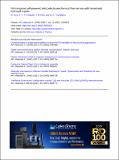Fish-inspired self-powered microelectromechanical flow sensor with biomimetic hydrogel cupula
Author(s)
Bora, M.; Kottapalli, A. G. P.; Miao, J. M.; Triantafyllou, Michael S
Download1.5009128.pdf (12.05Mb)
PUBLISHER_CC
Publisher with Creative Commons License
Creative Commons Attribution
Terms of use
Metadata
Show full item recordAbstract
Flow sensors inspired from lateral line neuromasts of cavefish have been widely investigated over decades to develop artificial sensors. The design and function of these natural sensors have been mimicked using microelectromechanical systems (MEMS) based sensors. However, there is more to the overall function and performance of these natural sensors. Mimicking the morphology and material properties of specialized structures like a cupula would significantly help to improve the existing designs. Toward this goal, the paper reports development of a canal neuromast inspired piezoelectric sensor and investigates the role of a biomimetic cupula in influencing the performance of the sensor. The sensor was developed using microfabrication technology and tested for the detection of the steady-state and oscillatory flows. An artificial cupula was synthesized using a soft hydrogel material and characterized for morphology and mechanical properties. Results show that the artificial cupula had a porous structure and high mechanical strength similar to the biological canal neuromast. Experimental results show the ability of these sensors to measure the steady-state flows accurately, and for oscillatory flows, an increase in the sensor output was detected in the presence of the cupula structure. This is the first time a MEMS based piezoelectric sensor is demonstrated to detect steady-state flows using the principle of vortex-induced vibrations. The bioinspired sensor developed in this work would be investigated further to understand the role of the cupula structure in biological flow sensing mechanisms, thus contributing toward the design of highly sensitive and efficient sensors for various applications such as underwater robotics, microfluidics, and biomedical devices.
Date issued
2017-10Department
Massachusetts Institute of Technology. Department of Mechanical EngineeringJournal
APL Materials
Publisher
American Institute of Physics (AIP)
Citation
Bora, M. et al. “Fish-Inspired Self-Powered Microelectromechanical Flow Sensor with Biomimetic Hydrogel Cupula.” APL Materials 5, 10 (October 2017): 104902 © 2017 Author(s)
Version: Final published version
ISSN
2166-532X